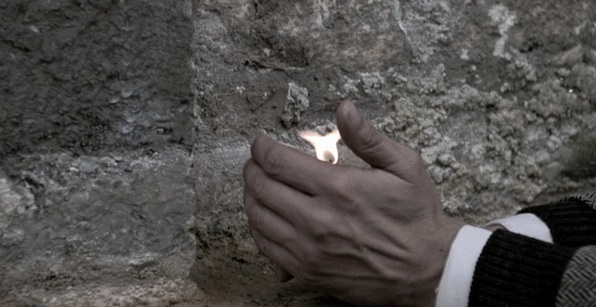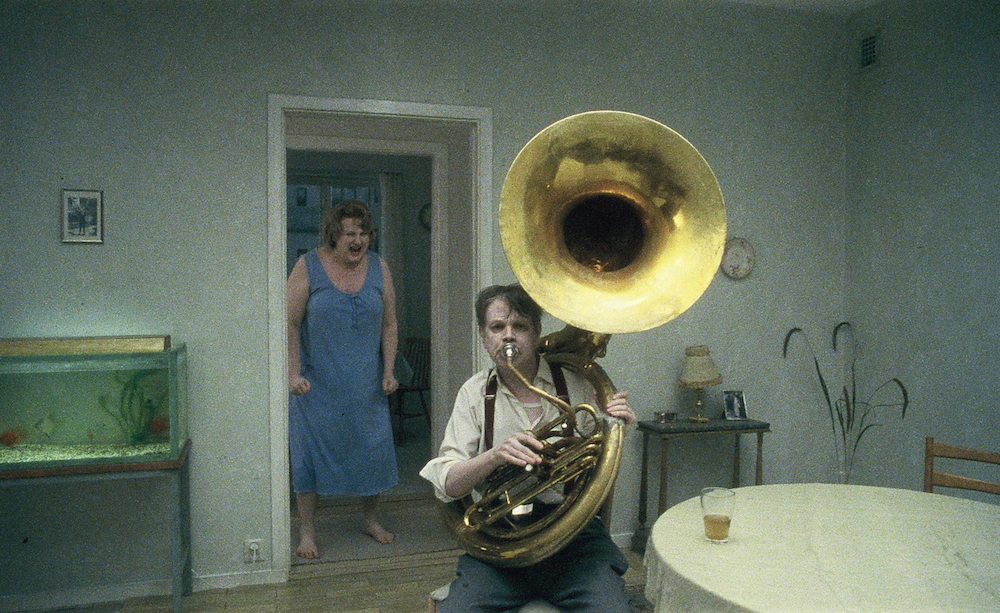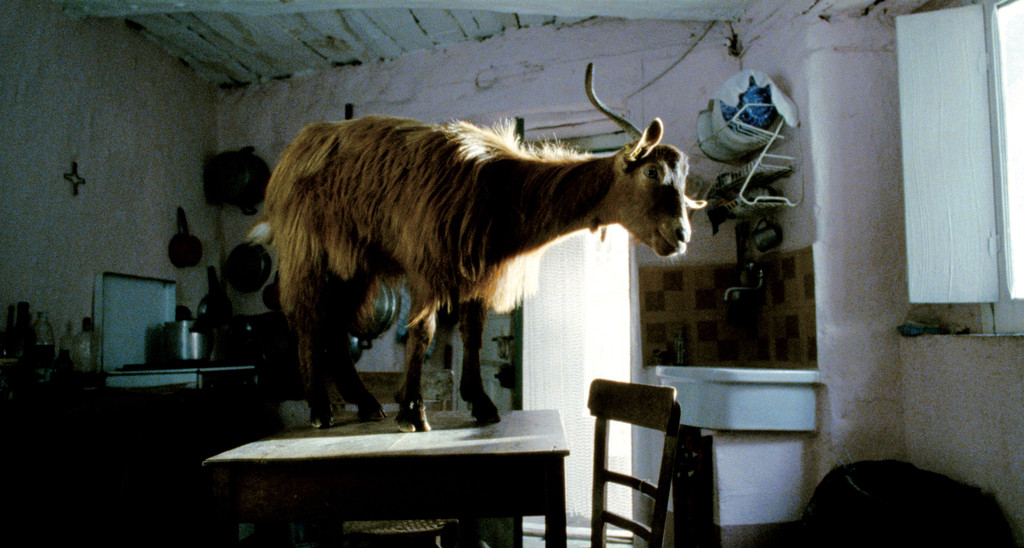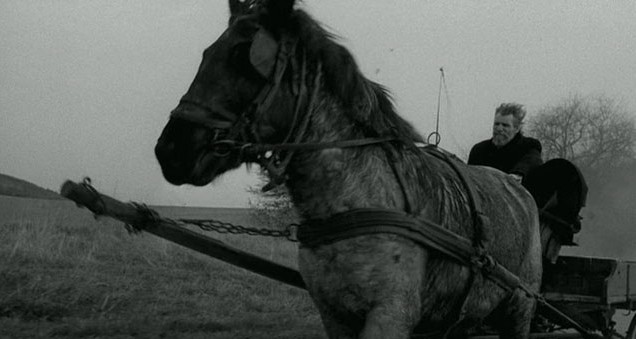[For more of “Fifty Days, Fifty Lists,” see “Why Lists?” here on Keyframe.]
There’s always something special about a great long-take. Though it can be as routinized as any other formal device, the long-take retains, in the right hands, an exhilarating appeal: it intensifies time by making us feel it, heightening the incidents unfolding within the frame. Framing is also to do with space: a long-take orients us in a filmic world in a way that’s very distinct from montage. While the latter assembles space brick-by-brick, a long-take allows us to see it more fully, and less segmented, as a lived-in locale.
Time is infectious. It’s a key part to any notion of cinema as an empathy machine. Consider Chantal Akerman’s Jeanne Dielman (1975), and the ways in which its protagonist’s daily routine begins to take on attributes of a grueling, monotonous ritual. That’s to do with the sheer time we as viewers spend in the film’s unglamorous domestic space: its power is cumulative. Montage is also cumulative, of course, but the long-take demands a different kind of attention: lingering on a scene for longer than we are perhaps used to, the camera invites our eyes to investigate—and perhaps our minds to wander.
The long-take also ensures that an eventual scene-break becomes revelatory. Think of the relief one feels when the more unbearable scenes in Michael Haneke’s Funny Games (1997) are finally allowed to end. At the same time, there’s something strangely addictive about a scene once it has established an appreciably lengthier duration than normal: one secretly wishes it’ll go on forever, testing the cameraperson’s limits as well as one’s own. When a set-piece ends in, say, Alfonso Cuarón’s Children of Men (2006), it’s like someone has let the air out of a balloon.
Maybe this has something to do with our human curiosity for extremes. Maybe it’s to do with our suspension of disbelief. Indeed, long-takes lend plausibility to action that might otherwise be suspected as trickery. There’s good reason, for instance, why all simulated car chases compare unfavorably to C’etait un rendezvous (1976), Claude Lelouche’s illegally-shot single-take race through Paris. To this end, think also of some of the beguilingly immersive action sequences in John Hyams’s Universal Soldier: Regeneration (2009).
Perceptions of time differ from age to age, of course, as well as from culture to culture. Early films such as the Lumières’ panoramas lasted no longer than a minute, yet they were exciting precisely because they presented a spectacularly real scenario with uninterrupted verisimilitude: they were moving pictures, capturing a pre-existing space but existing temporally. As film stocks advanced, so too did the possibilities of the long-take. In dialectical relationship to the age that bore it, the cinema helped to quicken life up. In response, many filmmakers have attempted to slow things down. One recalls here names such as Sharon Lockhart, James Benning, Andy Warhol and countless others, all of whom have taken the long-take to its durational limits.
Today, digital cinematography allows for a theoretically endless take. With Alejandro González Iñarritu’s Birdman unveiled recently, many writers looked back at Hitchcock’s Rope (1948). Both films give the illusion of their action unfolding in a single, feature-length take. In each film, there’s an element of showmanship. Hitchcock raises the tension by condensing story time to match narrative time and have all his action unfold in one digestible space, while González Iñarritu tells his story with effortlessly conveyed leaps and enthralling, how-did-they-do-that ellipses. In doing so, he effectively one-ups fellow Mexican Cuarón, whose aforementioned Children of Men and last year’s Gravity (2013) set the bar for commercial, action-packed films employing aesthetic choices ordinarily associated with the avant-garde.
The long-take has something also to do with dance—our fascination with it, our appreciation of it, our inclination to partake in it, even our need for it. Think of the virtuosity involved in choreographing a Brian De Palma set-piece like the opening of Snake Eyes (1998) or that crab-like track along a traffic jam in Godard’s Weekend (1967). In this sense, long-takes don’t just reward flightily far-out scenarios. Mike Figgis’s Timecode (2000) interweaves four split-screened feature-length takes at once, while Cristóbal Arteaga Rozas’s The Sad Smell of Flesh (2013) follows a debt-ridden businessman through Madrid’s unnavigably disorienting urban sprawl for eighty-seven-minutes with the persistence of a loyal dog desperate not to be left behind by its owner.
The long-take endures. We’re still not bored of it, and one senses that the most acclaimed cinematic achievements year in year out have something to do with the perseverance of the unbroken shot: with much awe, we look to what is arguably 2014’s best debut feature, Myroslav Slaboshpytskiy’s The Tribe, and its somehow renewing use of the long-take as a wondrous, are-you-ready-for-this phenomenon. Some more great long-takes ahead. . . .
The Red and the White (Miklós Jancsó, 1967)
Hungarian director Miklós Jancsó’s masterpiece is at once grueling and beautiful in its depiction of the 1918 Russian Civil War. It comprises a mere eighty-four shots over its ninety-one minutes, though some are longer than others. Late in the film, one five-minute take highlights Jancsó’s skills in conveying several planes of action in one imagistic space, by edging back and forth along a deceptively short dolly track and using a combination of zooms. Kevin B. Lee dissects the complex choreography of the scene in a video essay for Fandor here. (Cinematographer: Tamás Somló)
Nostalghia (Andrei Tarkovsky, 1983)
The first of two films Tarkovsky made in exile from his native Russia (the second was his final film, 1985’s The Sacrifice), this is full of the director’s trademark long-takes. Towards the end of the film, however, is a particularly self-reflexive one, which centers around the film’s protagonist, Andrei (Oleg Yankovsky), edging from one end of a hot mineral pool to the other with a flickering candle cupped in his hand. The shot, which lasts nine minutes, takes as long as it does for the candle to be carried—but there’s a twist: teasingly, the candle keeps going out, and Andrei must start again. (Cinematographer: Giuseppe Lanci)
Russian Ark (Alexander Sokurov, 2002)
Make what you will of a film all about Russian history that conveniently stops four years shy of the Bolshevik Revolution—to say nothing of its overall emphasis upon the country’s propertied and uniformed classes—but this is an astounding 99-minute continuous take. A dreamily inquisitive roam through St. Petersburg’s enormous and opulent State Hermitage Museum through the eyes of a wandering visitor and his sarcastic accomplice, a 19th century French Marquis, Sokurov’s hi-falutin’ folly is a gorgeous walk through time. If you like Steadicam (and why wouldn’t you?), this is still the film to end all films. (Cinematographer: Tilman Büttner)
Silent Light (Carlos Reygadas, 2007)
It might be cheating to include an obviously manipulated shot here, but then there’s always a fine line between pretension and necessity in Carlos Reygadas’ films. The Mexican maverick has a knack for opening his films, too: here, one rural dawn breaks over a Mennonite community in rural Chihuahua, and Reygadas condenses the cosmic shift into one sublime, five-minute take. Manipulation schmanipulation: such beauty! (Cinematographer: Alexis Zabé)
You, the Living (Roy Andersson, 2007)
The interplay between stasis and choreographed movement is the root of Roy Andersson’s absurdist brand of humor. The deadpan hilarity and incremental tension of the unbroken vignettes in his films are all in some way linked to the unchangingly glacial pace and moments of quiet variation. An hour and a quarter into this, the second in his ‘existence trilogy’ between Songs From the Second Floor (2000) and this year’s Golden Lion winner, A Pigeon Sat on a Branch Reflecting On Existence, is a dream sequence depicting a honeymoon, in which the groom serenades his bride with a laidback tuned on his electric guitar. At five minutes, it’s an otherwise typical Andersson take, and there are longer ones across the trilogy, but none match the extraordinary revelation here that the landscape outside is actually moving—or rather, the newlyweds’ home is, as if it’s a train carriage styled after a modern Swedish home, which comes to a standstill by a crowd of well-wishers outside. (Cinematographer: Gustav Danielsson)
Le quattro volte (Michelangelo Frammartino, 2010)
A document of life in Italy’s mountainous region of Calabria, Le quattro volte seemed to transcend human perspectives when it first came out. Dancing narrative perspectives, from a goatherd to a goat, then to a tree and, finally, a charcoal kiln, is matched by an almost pantheistic sense of inclusivity. At around the 27 minute mark, Frammartino sets his camera atop a hillside and watches, in one eight-minute take, a sheepdog create a scene of conducted chaos as it tries to alert the town of its owner’s death. It’s all the more incredible for the canine’s demonstrable intelligence and the extent to which the director was able to choreograph the whole sequence in one uninterrupted shot. (Cinematographer: Andrea Locatelli)
Aurora (Cristi Puiu, 2010)
One of the defining features of the Romanian New Wave has been its consistent emphasis upon the quotidian, and how its depiction of everyday life in post-communist Romania is one of monotonous repetition, as ordinary people get caught between hard rocks and difficult places within the deep recesses of dreary corridors and bureaucratic red tape—all of which is heightened by a penchant for the long-take. Aurora is a long film about killing, and its protagonist’s inability to perspectivise is encapsulated by Puiu’s simple decision to shoot all scenes from a tripod-fixed vantage point, able to pan left and right and tilt up and down but unable to track forward and enter the action. Of the film’s many obstinately unflinching takes, the most powerful comes right at the end, in a ten-minute shot of three men discussing a crime. Also read: Gestures: Bureaucracy and Other Horrors. (Cinematographer: Viorel Sergovici)
The Turin Horse (Béla Tarr, 2011)
There are typically numerous examples of the choreographed long-take in this, the final film by long-take maestro Béla Tarr, in which simple repetition lends a taxing sense of ritual to the daily lives of a horse owner and his daughter. But the most beautiful take is the first, a five-minute tracking shot of the eponymous creature, windswept, weather-beaten, its head bobbing indefatigably as it progresses along a dusty path to the melancholic growl of Mihály Víg’s beautiful string score. (Cinematographer: Fred Kelemen)
Manakamana (Stephanie Spray and Pacho Velez, 2013)
Falling on the more absorbing side of patience-testing, this ethnographic portrait of various passengers and pilgrims taking a cable car to and from a 17th century temple atop a mountain range in Nepal consists of eleven fixed-point Super 16mm long-takes between nine and ten minutes long—each reel lasting the length of one observational cable car journey. (Cinematographer: Pacho Velez)
A Spell to Ward Off the Darkness (Ben Rivers and Ben Russell, 2013)
Ben Russell’s remarkable debut feature, Let Each One Go Where He May (2009), comprised thirteen continuous takes across its 134-minute running time. A Spell to Ward Off the Darkness, Russell’s first feature in collaboration with Ben Rivers, somehow betters the sustained energy and subsequent absurdity of anything in the earlier film: the final part of this contemplative triptych takes place at a loud, aggressive, strobe-lit black metal concert that unfolds in one single take, the camera floating between the lead singer and the bobbing, hypnotized faces of his audience. (Cinematographers: Ben Rivers, Ben Russell)









